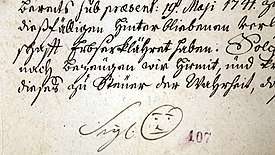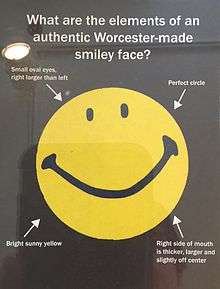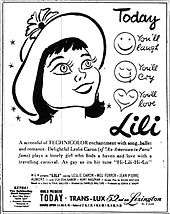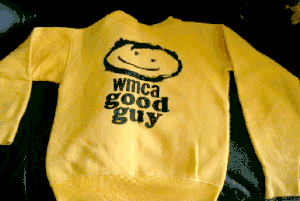Smiley
| Smiley | |
|---|---|
 |
A smiley (sometimes called a happy face yellow smile 😃 smiley face) is a stylized representation of a smiling humanoid face that is a part of popular culture worldwide. The classic form designed by Harvey Ball in 1963 comprises a yellow circle with two black dots representing eyes and a black arc representing the mouth (![]()
:-), :), or (: that resemble a smiling face when viewed after rotation through 90 degrees. "Smiley" is also sometimes used as a generic term for any emoticon. The smiley has been referenced in nearly all areas of Western culture including music, movies, and art. The smiley has also been associated with late 1980s and early 1990s rave culture.[1][2][3]
The plural form "smilies" is commonly used,[4] but the variant spelling "smilie" is not as common as the "y" spelling.[5]
History
Around 2017, a team of archaeologists led by Nicolò Marchetti of the University of Bologna pieced together the fragments of a Hittite pot from approximately 1700 BC that had been found in Karkamış, Turkey. After it was pieced together, the team saw that it had what appeared to be a large smiley face painted on it.[6]

The Danish poet and author Johannes V. Jensen was amongst other things famous for experimenting with the form of his writing. In a letter sent to publisher Ernst Bojesen in December 1900 he includes both a happy face and a sad face, resembling the modern smiley.
A commercial version of a smiley face with the word "THANKS" above it was available in 1919 and applied as a sticker on receipts issued by the Buffalo Steam Roller Company in Buffalo New York. The round face was much more detailed than the one depicted above, having eyebrows, nose, teeth, chin, facial creases and shading, and is reminiscent of "man-in-the-moon" style characterizations.
Ingmar Bergman's 1948 film Port of Call includes a scene where the unhappy Berit draws a sad face – closely resembling the modern "frowny", but including a dot for the nose – in lipstick on her mirror, before being interrupted.[7] In 1953 and 1958, similar happy faces were used in promotional campaigns for the films Lili and Gigi.
The smiley was first introduced to popular culture as part of a promotion by New York radio station WMCA beginning in 1962. Listeners who answered their phone "WMCA Good Guys!" were rewarded with a "WMCA good guys" sweatshirt that incorporated a happy face into its design. Thousands of these sweatshirts were given away.[8][9][10] The WMCA smiley was yellow with black dots as eyes, had a slightly crooked smile, and had no creases at the sides of the mouth.[10]
According to the Smithsonian Institution, the smiley face as we know it today was created by Harvey Ross Ball, an American graphic artist.[11] In 1963, Harvey Ball was employed by State Mutual Life Assurance Company of Worcester, Massachusetts (now known as Hanover Insurance) to create a happy face to raise the morale of the employees. Ball created the design in ten minutes and was paid $45 (equivalent to US$330 in 2012 currency). His rendition, with bright yellow background, dark oval eyes, full smile and creases at the sides of the mouth,[10] was imprinted on more than fifty million buttons and became familiar around the world. The design is so simple that it is certain that similar versions were produced before 1963, including those cited above. However, Ball’s rendition, as described here, has become the most iconic version.[9][12] In 1967, Seattle graphic artist George Tenagi drew his own version at the request of advertising agent, David Stern. Tenagi's design was used in an advertising campaign for Seattle-based University Federal Savings & Loan. The ad campaign was inspired by Lee Adams's lyrics in "Put on a Happy Face" from the musical Bye Bye Birdie. Stern, the man behind this campaign, also later incorporated the Happy Face in his run for Seattle mayor in 1993.[12]
The graphic was further popularized in the early 1970s by Philadelphia brothers Bernard and Murray Spain, who seized upon it in September 1970 in a campaign to sell novelty items. The two produced buttons as well as coffee mugs, t-shirts, bumper stickers and many other items emblazoned with the symbol and the phrase "Have a happy day" (devised by Gyula Bogar),[13] which mutated into "Have a nice day". Working with New York button manufacturer NG Slater, some 50 million happy face badges were produced by 1972.[14]
In 1972, Frenchman Franklin Loufrani became the first person to legally trademark a use of a smiley face. He used it to highlight the good news parts of the newspaper France Soir. He simply called the design "Smiley" and launched The Smiley Company. In 1996 Loufrani's son Nicolas Loufrani took over the family business and built it into a multinational corporation. Nicolas Loufrani was outwardly skeptical of Harvey Ball's claim to creating the first smiley face. While noting that the design that his father came up with and Ball's design were nearly identical, Loufrani argued that the design is so simple that no one person can lay claim to having created it. As evidence for this, Loufrani's website points to early cave paintings found in France (2500 BC) that he claims are the first depictions of a smiley face. Loufrani also points to a 1960 radio ad campaign that reportedly made use of a similar design.[15]
In the UK, the happy face has been associated with psychedelic culture since Ubi Dwyer and the Windsor Free Festival in the 1970s and the electronic dance music culture, particularly with acid house, that emerged during the Second Summer of Love in the late 1980s. The association was cemented when the band Bomb the Bass used an extracted smiley from Watchmen on the centre of its "Beat Dis" hit single.
In text
The earliest known smiley-like image in a written document was drawn by a Slovak notary to indicate his satisfaction with the state of his town's municipal financial records in 1635.[16] A disputed early use of the smiley in a printed text may have been in Robert Herrick's poem To Fortune (1648),[17] which contains the line "Upon my ruines (smiling yet :)". Journalist Levi Stahl has suggested that this may have been an intentional "orthographic joke", while this occurrence is likely merely the colon placed inside parentheses rather than outside of them as is standard typographic practice today -- (smiling yet): . There are citations of similar punctuation in a non-humorous context, even within Herrick's own work.[18] It is likely that the parenthesis was added later by modern editors.[19]
On the Internet, the smiley has become a visual means of conveyance that uses images. The first known mention on the Internet was on September 19, 1982, when Scott Fahlman from Carnegie Mellon University wrote:
I propose that [sic] the following character sequence for joke markers: :-) . Read it sideways. Actually, it is probably more economical to mark things that are NOT jokes, given current trends. For this, use: :-(.[20][21]
In Software, yellow graphical smileys have been used for many different purposes, including games.[22] One of the earliest uses of smileys in chat systems was in Yahoo! Messenger from 1998, where it can be seen in the user list next to each user, and it was also used as an icon for the application. In 2001, SmileyWorld launched the website "The official Smiley dictionary",[23] with smileys proposed to replace ASCII emoticons (i.e. emojis). In November 2001, and later, smiley emojis inside the actual chat text was adopted by several chat systems, including Yahoo Messenger.
The smiley is the printable version of characters 1 and 2 of (black-and-white versions of) codepage 437 (1981) of the first IBM PC and all subsequent PC compatible computers. For modern computers, all versions of Microsoft Windows after Windows 95[24] can use the smiley as part of Windows Glyph List 4, although some computer fonts miss some characters, and some characters cannot be reproduced by programs not compatible with Unicode.[25] It also appears in Unicode's Basic Multilingual Plane.[26]
| Unicode smiley characters: | |||
| ☺ | U+263A | Alt+1 | White Smiling Face |
| ☻ | U+263B | Alt+2 | Black Smiling Face |
| Unicode also contains the "sad" face: | |||
| ☹ | U+2639 | White Frowning Face | |
Licensing and legal issues

The rights to the Smiley trademark in one hundred countries are owned by the Smiley Company.[27] Its subsidiary SmileyWorld Ltd, in London, headed by Nicolas Loufrani, creates or approves all the Smiley products sold in countries where it holds the trademark.[28] The Smiley brand and logo have significant exposure through licensees in sectors such as clothing, home decoration, perfumery, plush, stationery, publishing, and through promotional campaigns.[29] The Smiley Company is one of the 100 biggest licensing companies in the world, with a turnover of US$167 million in 2012.[30] The first Smiley shop opened in London in the Boxpark shopping centre in December 2011.[31]
United States
In 1997, Franklin Loufrani and Smiley World attempted to acquire trademark rights to the symbol (and even to the word "smiley" itself) in the United States. This brought Loufrani into conflict with Wal-Mart, which had begun prominently featuring a happy face in its "Rolling Back Prices" campaign over a year earlier. Wal-Mart responded first by trying to block Loufrani's application, then later by trying to register the smiley face itself; Loufrani in turn sued to stop Wal-Mart's application, and in 2002 after the issue went to court,[32] where it would languish for seven years before a decision.
Wal-Mart began phasing out the smiley face on its vests[33] and its website[34] in 2006. Despite that, Wal-Mart sued an online parodist for alleged "trademark infringement" after he used the symbol (as well as various portmanteaus of "Wal-", such as "Walocaust"). The District Court found in favor of the parodist when in March 2008, the judge concluded that Wal-Mart's smiley face logo was not shown to be "inherently distinctive" and that it "has failed to establish that the smiley face has acquired secondary meaning or that it is otherwise a protectible trademark" under U.S. law.[35]
In June 2010, Wal-Mart and the Smiley Company founded by Loufrani settled their 10-year-old dispute in front of the Chicago federal court. The terms remain confidential.[36] In 2016, Wal-Mart brought back the smiley face on its website, social media profiles, and in selected stores.[37]
See also
References
- ↑ Jon Savage (February 21, 2009). "Smiley Face Design History". Retrieved October 5, 2016.
- ↑ Michaelangelo Matos (December 21, 2016). "A Brief History of the Smiley Face, Rave Culture's Most Ubiquitous Symbol". Retrieved May 1, 2017.
- ↑ Lim, Brian (July 23, 2015). "The Evolution of Rave Fashion". Retrieved May 1, 2017.
- ↑ Google Ngram Viewer: smilies vs smileys
- ↑ Google Ngram Viewer: smilie vs smiley
- ↑ Borschel-Dan, Amanda (2017-07-19). "History's 'oldest smile' found on 4,000-year-old pot in Turkey". The Times of Israel. Retrieved 2017-07-28.
- ↑ Ingmarbergman.se. A still from the scene.
- ↑ Alastair Sooke (February 3, 2012), "Smiley's People (Radio 4): The million dollar smile", The Telegraph,
[Loufrani] points out that a smiley face was a key feature of a well-known promotional campaign for a radio network on America’s East Coast in the late Fifties.
- 1 2 Honan, William H. (April 14, 2001). "H. R. Ball, 79, Ad Executive Credited With happy Face". The New York Times. Retrieved August 29, 2009.
- 1 2 3 Doug Lennox, illustrated by Catriona Wight (2004), Now You Know More: The Book of Answers, Now You Know, 2 (illustrated ed.), Dundurn, p. 50, ISBN 9781550025309
- ↑ Stamp, Jimmy (13 March 2013). Who really invented the Smiley face. Washington DC: Smithsonian. Retrieved 29 May 2015.
- 1 2 Adams, Cecil (23 April 1993). "Who invented the smiley face?". The Straight Dope. Retrieved 18 April 2011.
- ↑ "web - Lame Adventures". Lameadventures.com.
- ↑ Peter Shapiro, "Smiling Faces Sometimes", in The Wire, issue 203, January 2001, pp. 44–49.
- ↑ Jimmy Stamp. "Who Really Invented the Smiley Face?". Smithsonian.
- ↑ Votruba, Martin. "17th-century Emoji". Slovak Studies Program. University of Pittsburgh.
- ↑ Madrigal, Alexis C. (14 April 2014). "The First Emoticon May Have Appeared in ... 1648". The Atlantic. Retrieved 15 April 2014.
- ↑ "Emoticon: Robert Herrick's 17th century poem "To Fortune" does not contain a smiley face". Slate Magazine.
- ↑ "smileys, emoticons, typewriter art". Text Patterns - The New Atlantis.
- ↑ Fahlman's original message Retrieved October 27, 2013.
- ↑ "Smiley Lore :-)". cmu.edu.
- ↑ "Atari 2600 › Smiley › PDRoms - Homebrew 4 you". Pdroms.de. 18 July 2007. Retrieved 21 September 2018.
- ↑ "Wayback Machine". Web.archive.org. 31 March 2001. Retrieved 21 September 2018.
- ↑ "WGL Assistant v1.1: The Multilingual Font Manager". Archived from the original on 24 March 2008.
- ↑ Announcing WGL Assistant. Announcement: WGL Assistant V1.1 Beta available, comp.fonts, 27 July 1999, Microsoft Typography – News archive.
- ↑ wikibooks:Unicode/Character reference/2000-2FFF
- ↑ Crampton, Thomas (5 July 2006). "Smiley Face Is Serious to Company". The New York Times.
- ↑ "The Man Who Owns the Smiley Face". Vice. 2017-08-10. Retrieved 2018-01-24.
- ↑ "Smiley Licensing | Company Profile by". Licensing.biz. Archived from the original on February 29, 2012. Retrieved 2013-03-14.
- ↑ "Global License : Ranking the brands" (PDF). Rankingthebrands.com. Retrieved 21 September 2018.
- ↑ Giedrius Ivanauskas (2012-01-16). "Boxpark Shoreditch: Interview with Nicolas Loufrani CEO of Smiley | Made in Shoreditch - A Magazine About Style, Innovation, Dining, Nightlife and People in Shoreditch". Made in Shoreditch. Archived from the original on 2013-03-07. Retrieved 2013-03-14.
- ↑ "Wal-Mart seeks smiley face rights". BBC News. 8 May 2006. Retrieved 2006-05-09.
- ↑ Kabel, Mark (October 22, 2006). "Wal-Mart phasing out smiley face vests". Associated Press.
- ↑ Williamson, Richard (October 30, 2006). "The last days of Wal-Mart's smiley face". Adweek.
- ↑ "Smith v. Wal-Mart Stores, Inc". Citizen Vox. 28 March 2008. The relevant text is in the Order granting summary judgment: Timothy C. Batten, Sr., "ORDER" (03/21/2008)", section "B. Threshold Issue: Trademark Ownership", case "1:06-cv-00526-TCB", document 103, pages 15-19
- ↑ Sony, Astellas, Intel, Apple, Wal-Mart, Warner: Intellectual Property Victoria Slind-Flor, Jul 1, 2011, Bloomberg. The case is Loufrani v. Wal-Mart Stores Inc., 1:09-cv- 03062, U.S. District Court, Northern District of Illinois (Chicago).
- ↑ Smith, Aaron (2016-06-02). "Walmart's Smiley is back after 10 years and a lawsuit". CNNMoney. Retrieved 2017-01-18.
External links
| Wikimedia Commons has media related to: |

